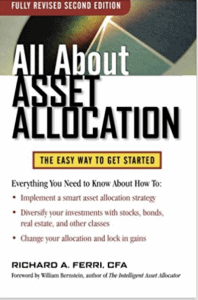DIY Investing Resource #4: All About Asset Allocation
The following post was originally published on Eat the Financial Elephant in March 2015, shortly after my wife and I dug out from under our past investing mistakes. It is the fourth of the four most valuable resources that helped us go from feeling clueless to competent managing our investment portfolio.
Our fourth selected DIY investing resource is “All About Asset Allocation“ by Richard Ferri, CFA. The book is divided into three parts:
- Asset Allocation Basics
- Asset-Class Selection
- Managing Your Portfolio.
 Our first three resources, “The Stock Series“, “The Little Book of Common Sense Investing“, and “The Intelligent Asset Allocator” provided the conceptual and theoretical framework to manage our investments. Parts one and three of “All About Asset Allocation” were primarily a review and reinforcement of those principles. There were a few unique insights which we will discuss briefly.
Our first three resources, “The Stock Series“, “The Little Book of Common Sense Investing“, and “The Intelligent Asset Allocator” provided the conceptual and theoretical framework to manage our investments. Parts one and three of “All About Asset Allocation” were primarily a review and reinforcement of those principles. There were a few unique insights which we will discuss briefly.
The Asset-Class Selection portion is uniquely detailed and helpful and why we included this book in our selected resources. This section of the book provided specifics that allowed us to construct our portfolio with confidence. This will be where we focus the review.
Asset Allocation Basics
The first section of this book explains basic investment principles to understand investment risk, the concepts of asset allocation, and the reasoning behind multi-asset class investing. Ferri provides a clear framework to choose what investments should be included in a portfolio. Each selected asset class should:
- Have a real expected return that is greater than inflation.
- Have risks that are fundamentally different from each other.
- Be accessible with a liquid, low-cost product or fund.
Asset-Class Selection
This section of the book made it the most practical resource for those of us who choose a path of index investing with some increased diversification and complexity over simply owning a S&P 500 or Total Market index fund. Each chapter in this section provided some unique and useful information. I’ll highlight some key points.
US Equities
- This chapter reinforced the importance of holding a domestic total market index fund as a core fund. The other take home point I took is the potential advantage of tilting a portion of US equities to small and value stocks. These subsets of the market are under-represented in traditional market capitalization weighted indices. Historically they have produced higher returns than the overall market. This book also discusses holding the smallest (micro-cap) stocks. They historically have produced returns in excess of other segments of the market. However, they also present a challenge in finding a cost-effective way of holding them.
International Equities
- This book clearly explained the currency risk (and potential benefit) of owning foreign stocks. When the US dollar is strong, investors profit more by simply owning US stocks. As the dollar weakens, there is more benefit to owning foreign stocks. This relationship is cyclical. There will be times when having international currency exposure will be beneficial, representing another diversification opportunity.
- Ferri did a good job explaining that there is no such thing as a “multinational firm”. A common argument against owning foreign stocks is that large US corporations do a large portion of business internationally, giving you international exposure. This chapter explains that each company is based in only one country for accounting and tax purposes. Thus, foreign equities must be owned separately to obtain the diversification benefit. They present unique risks and opportunities to US equities.
- An interesting case was made for owning separate US and foreign funds, rather than owning one global fund. Likewise, a case was made for further dividing international equities among European, Pacific Rim and Emerging Markets instead of owning only a single international fund. At different times, certain countries or regions tend to be dominant economically. This will be reflected by their domination of a total international fund at any time. Slicing the portfolio into these segments gives opportunity for better returns over time by periodically rebalancing.
Fixed Income Investments (Bonds)
- Ferri went into great detail on the many different opportunities to diversify the bond portion of a portfolio. He explained how bonds can be used to complement other asset classes to increase long-term portfolio return.
- There is an excellent explanation of the different risks associated with different bonds including interest rate, maturity, default, and inflation/deflation risks.
- While the author reinforced the idea of a diversified core Total Bond Market Fund, he also demonstrated that these funds don’t include Treasure Inflation Protected Securities (TIPS), high-yield corporate bonds, or international bonds. He explained why you may want to hold these for further diversification of your portfolio.
- There is also a detailed explanation of when and for whom tax-exempt municipal bonds may be preferable to taxable bonds.
Real Estate
- Ferri did a nice job of explaining the difference between a primary residence and investment real estate. He argues that a primary residence is an asset that should appreciate with inflation. However, it should be considered as shelter and not a part of the investment portfolio because it is not liquid and has little real return above inflation.
- The features that make investment real estate attractive are that it tends to appreciate at, or slightly greater than, the rate of inflation while also providing income in the form of rents. Thus it has a growth and income component.
- Real estate investment trusts (REIT) were described as a convenient, widely diversified way to own real estate. They have variable correlation with stocks and bonds making them attractive to hold in a portfolio. Their total real return is expected to be similar to that of stocks.
- A REIT provides a convenient way to own real estate without worrying about someone calling at 3 A.M. to tell you they had a pipe burst or the furnace is out. However, with that convenience you have a more efficient market. This means you lose much of the potential upside as well as the leverage potential of traditional real estate investing.
Alternative Investments
- Ferri covered several alternative investments. While he did not recommend any of them for most people’s portfolios, the information contained was very useful to avoid being sucked into the hype that often surrounds them.
- Commodities ranging from gold to crude oil to pork bellies were explained. All are the same in that they offer no consistent long-term growth potential and no way of providing income. Instead, money is made through speculation and market timing.
- Hedge Funds are often mysterious and alluring to investors. The author points out that they have different regulations than other securities, have very high investment costs, lack diversification, and have poor consistency of performance.
- Collectibles were described as potentially personally rewarding and enjoyable. However, they can have high costs to acquire, store, and insure and require expertise. They also are illiquid and are dependent on supply and demand and finding a buyer.

Managing Your Portfolio
This third section of the book covers realistic market expectations, building your portfolio, how behavior affects asset allocation decisions, when to change asset allocation, and the effect of fees in asset allocation planning.
It provides sample portfolios with specific funds and allocations. We used these as templates when building our own portfolio. We also followed Ferri’s recommendation of writing out an investment plan with our asset allocation and pre-established reasoning of when and why we would make changes. This helped us to develop a plan to follow and will likely prevent mistakes in the future as we refer back to it before considering any changes.
Of particular interest to us given our experiences and criticisms of the financial advice industry was Ferri’s input on hiring an investment adviser. His book is balanced and objective. He makes some valid points about why people should have an advisor and also is very candid in criticism of the industry. He offers his opinions of the difference between those who are selling products and those who sell advice.
Of note, at the time this review was originally written, Ferri’s own firm required a minimum of $500,000 to be accepted as a client where they managed funds with an assets under management model. While he provides useful advice and insights for those that have built savings, his advice reinforces the point we often make. It is very challenging for a person starting out to get quality service from the financial industry. This is why there is such a need for self-education.
Final Thoughts
Thankfully, there are resources out there to help us DIY investors to educate ourselves. If you are looking for one that is thorough and extremely practical to assist you in designing, building, and managing your investment portfolio, then I would highly recommend Rick Ferri’s “All About Asset Allocation.”
* * *
Valuable Resources
* * *
Disclosure: Can I Retire Yet? has partnered with CardRatings for our coverage of credit card products. Can I Retire Yet? and CardRatings may receive a commission from card issuers. Some or all of the card offers that appear on the website are from advertisers. Compensation may impact on how and where card products appear on the site. The site does not include all card companies or all available card offers.
Other links on this site, like the Amazon, NewRetirement, Pralana, and Personal Capital links are also affiliate links. As an affiliate we earn from qualifying purchases. If you click on one of these links and buy from the affiliated company, then we receive some compensation. The income helps to keep this blog going. Affiliate links do not increase your cost, and we only use them for products or services that we're familiar with and that we feel may deliver value to you. By contrast, we have limited control over most of the display ads on this site. Though we do attempt to block objectionable content. Buyer beware.